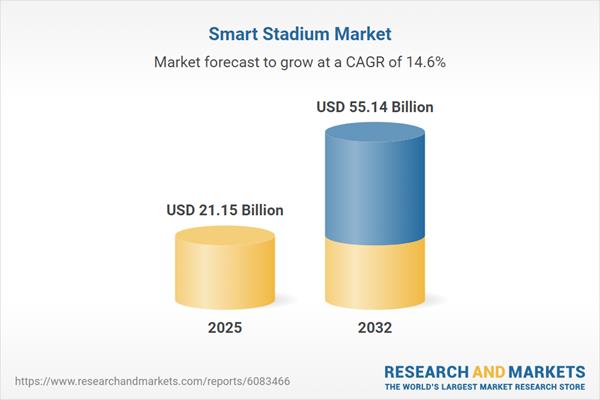Speak directly to the analyst to clarify any post sales queries you may have.
The smart stadium market is undergoing rapid transformation as advanced technologies redefine the operational and experiential landscape for sports venues worldwide, setting new standards for efficiency, security, and fan engagement.
Market Snapshot: Smart Stadium Market Growth & Dynamics
The Smart Stadium Market grew from USD 18.57 billion in 2024 to USD 21.15 billion in 2025, with continued expansion projected at a CAGR of 14.56%, reaching USD 55.14 billion by 2032. This growth is propelled by the integration of technologies such as sensor networks, digital analytics, and automated systems, all tailored to meet evolving stakeholder expectations and audience needs.
Scope & Segmentation: Smart Stadium Ecosystem
- Offerings: Service, Consulting Services, Support & Maintenance Services, System Integration Services, Software, Building Automation Software, Energy Management Software, Maintenance Management Systems, Crowd Management Software, Crowd Analytics Software, Queue & Flow Management Software, Event Management Software, Stadium & Public Safety Software, Incident Management Software, Security Software & Solutions
- Stadium Type: Indoor stadiums, Multipurpose stadiums, Outdoor stadiums
- Deployment Mode: Cloud-based, On-Premises
- Application: Event Management, Facility Management, Fan Engagement Solutions, In-Stadium Connectivity, Seating & Ticketing Solutions, Security & Surveillance, Transportation Management
- Regional Coverage: Americas (North America: United States, Canada, Mexico; Latin America: Brazil, Argentina, Chile, Colombia, Peru), Europe, Middle East & Africa (United Kingdom, Germany, France, Russia, Italy, Spain, Netherlands, Sweden, Poland, Switzerland, United Arab Emirates, Saudi Arabia, Qatar, Turkey, Israel, South Africa, Nigeria, Egypt, Kenya), Asia-Pacific (China, India, Japan, Australia, South Korea, Indonesia, Thailand, Malaysia, Singapore, Taiwan)
- Key Technology Providers: ABB Ltd., Allied Telesis, Inc., AT&T Inc., Cellnex Telecom, S.A., Cisco Systems, Inc., Cognizant Technology Solutions Corporation, Fujitsu Limited, GP Smart Stadium, Hewlett Packard Enterprise Company, Hospitality Network, LLC by Cox Business, Huawei Technologies Co., Ltd., Intel Corporation, International Business Machines Corporation, Johnson Controls International PLC, Lumen Technologies, Inc, N3XT Sports LLC, NEC Corporation, NTT Data Group Corporation, NXP Semiconductors N.V, PARTTEAM & OEMKIOSKS, Qualcomm Incorporated, SA Group, Sony Group Corporation, Tech Mahindra Limited, Telefonaktiebolaget LM Ericsson
Key Takeaways: Strategic Insights for Leaders
- Smart stadiums are leveraging AI, IoT, and biometric systems to streamline operations and enhance personalized fan experiences.
- Interactive digital solutions, such as augmented reality wayfinding and mobile-enabled in-seat services, are reshaping audience engagement strategies.
- Venue operators are adopting digital twins and predictive analytics for efficient planning, risk mitigation, and resource optimization.
- Regulatory compliance and sustainability efforts are driving adoption of energy management and secure data governance frameworks to meet stakeholder and legislative requirements.
- Flexible, open architecture and platform-as-a-service models support the integration of emerging technologies without costly infrastructure overhauls.
- Collaboration across technology partners, venue managers, and local authorities accelerates deployment and enables innovative business models.
Tariff Impact on Smart Stadium Technology Supply Chains
- Recent U.S. tariffs have affected costs and sourcing across hardware components, prompting shifts to regional assembly hubs and modular upgrade strategies.
- Venue operators increasingly segment deployments and renegotiate agreements to maintain resilience against evolving global trade dynamics.
- Stakeholders are focusing on alternative materials, flexible logistics, and collaborative supplier ecosystems to enhance operational continuity amid policy shifts.
Methodology & Data Sources
This analysis utilizes a robust methodology, combining structured interviews with venue operators, integrators, and domain experts. Quantitative insights are drawn from vendor reports, regulatory documents, industry publications, and comprehensive secondary research, validated through triangulation and subject matter reviews to ensure accurate, reliable findings.
Why This Report Matters: Actionable Intelligence for Decision Makers
- This report provides tailored, actionable insights to guide investment strategies and technology selection in the evolving smart stadium market.
- Decision makers gain a clear view of competitive differentiation, regulatory drivers, and new monetization opportunities across global regions.
- Stakeholders can benchmark adoption models, risk mitigation strategies, and sustainability frameworks against industry best practices for future-ready operations.
Conclusion
The smart stadium sector is redefining value creation through digital convergence, intelligent analytics, and collaborative partnerships. In this evolving landscape, proactive leadership and agile execution will distinguish those best positioned for sustainable growth and operational excellence.
Table of Contents
3. Executive Summary
4. Market Overview
7. Cumulative Impact of Artificial Intelligence 2025
Companies Mentioned
The companies profiled in this Smart Stadium market report include:- ABB Ltd.
- Allied Telesis, Inc.
- AT&T Inc.
- Cellnex Telecom, S.A.
- Cisco Systems, Inc.
- Cognizant Technology Solutions Corporation
- Fujitsu Limited
- GP Smart Stadium
- Hewlett Packard Enterprise Company
- Hospitality Network, LLC by Cox Business
- Huawei Technologies Co., Ltd.
- Intel Corporation
- International Business Machines Corporation
- Johnson Controls International PLC
- Lumen Technologies, Inc
- N3XT Sports LLC
- NEC Corporation
- NTT Data Group Corporation
- NXP Semiconductors N.V
- PARTTEAM & OEMKIOSKS
- Qualcomm Incorporated
- SA Group
- Sony Group Corporation
- Tech Mahindra Limited
- Telefonaktiebolaget LM Ericsson
Table Information
| Report Attribute | Details |
|---|---|
| No. of Pages | 196 |
| Published | November 2025 |
| Forecast Period | 2025 - 2032 |
| Estimated Market Value ( USD | $ 21.15 Billion |
| Forecasted Market Value ( USD | $ 55.14 Billion |
| Compound Annual Growth Rate | 14.5% |
| Regions Covered | Global |
| No. of Companies Mentioned | 26 |









